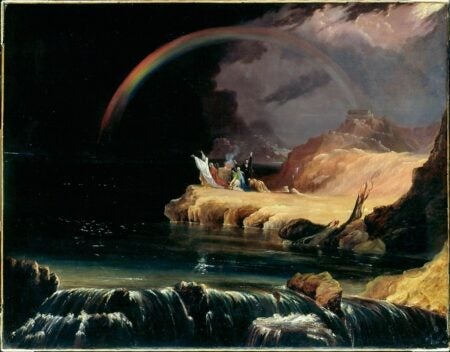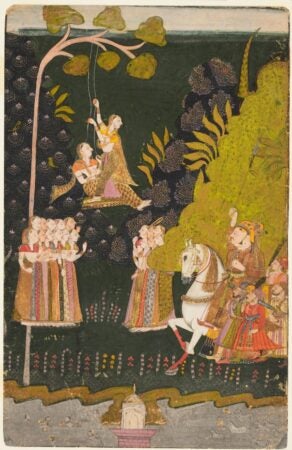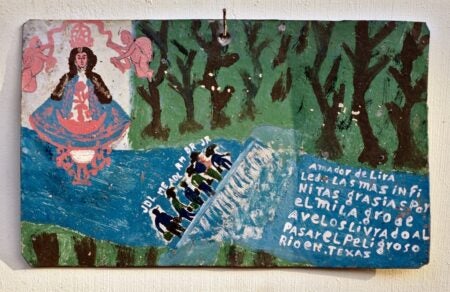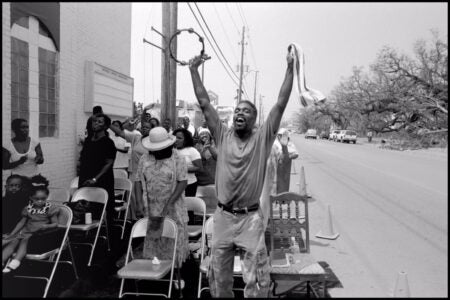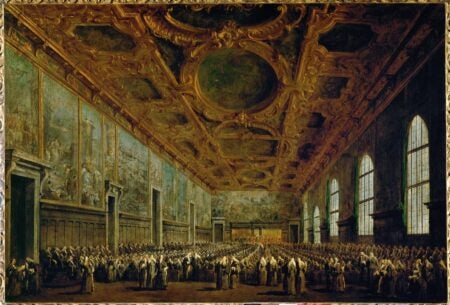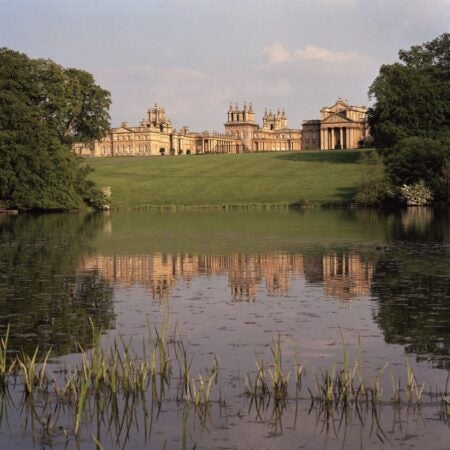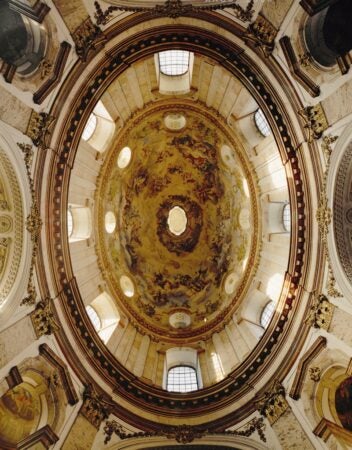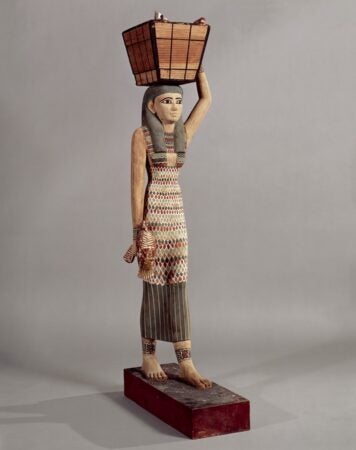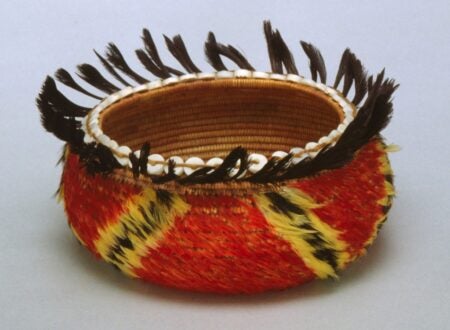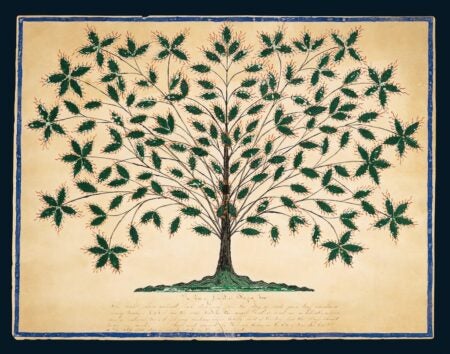Giving thanks

Bob Gore. Giving Thanks, Terrier Rouge, Haiti. 10 Oct. ‘07. Image and data from Bob Gore Productions, Inc.
We are on the cusp of the holiday season, a quiet, delicious pause before the big rush — a time when we slow down to reflect and give thanks. In the spirit of A.A. Milne’s inimitable philosopher Piglet, we may recall our capacity for gratitude: “Piglet noticed that even though he had a Very Small Heart, it could hold a rather large amount of Gratitude.” In celebration of Thanksgiving, we are highlighting expressions of thanks through time and across the world.
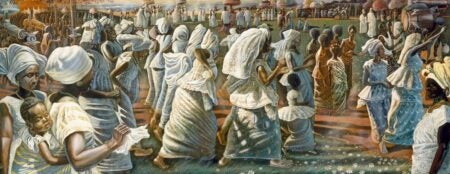
John Biggers. Jubilee Ghana Harvest Festival. 1959-1963. Image and data from the Museum of Fine Arts, Houston. © John T. Biggers Estate Licensed by VAGA, New York, NY.
A moment of grace bestills the bowed heads of three small Haitian girls captured by the photographer Bob Gore, while a swell of Ghanian women is moved by thankful joy during a Harvest Festival in a monumental painting by the African American artist John Biggers.
- John Martin. Noah Giving Thanks After the Flood. c. 1840. Image and data from The Art Institute of Chicago.
- Rajasthan, Marwar, Rajput Kingdom of Jodhpur. Maharaja Abhai Singh…watching girls swinging at the Teej Festival. c. 1740. Image and data from The Cleveland Museum of Art. Free Reuse. CC0.
- Retablo for Amador de Lira. Image and data from Jorge Durand and Douglas Massey. For the Mexican Migration Project.
- Larry Towell. USA. Biloxi, Mississippi…Parishioners worship …and give thanks…outside of their church flooded…by Hurricane Katrina. 2005. Image and data from Magnum Photos. © Larry Towell Magnum Photos.
The element of water provokes elation and fear, thanks being rendered for both its ebb and its flow: after the biblical flood, a triumphant Noah reaches heavenward in thanks in a painting by John Martin; an 18th-century illumination from Jodhpur, India displays courtly ladies swinging and cheering during the Teej Festival that heralds the coming of the monsoons; a modern Mexican retablo, a private offering, expresses thanks for protection during the traverse of a treacherous river in Texas, presumably in a border crossing; and boisterous jubilation animates the worship of survivors of Katrina in Biloxi, Mississippi in a photograph by Larry Towell.
- Francesco Guardi . After his election, the Doge thanks the Grand Council in … the Doge’s Palace. c. 1766-1780. Image and data from Erich Lessing Culture and Fine Arts Archives / ART RESOURCE, N.Y.
- Peter Marlow. G.B England. Blenheim Palace. 2004. Image and data from Magnum Photos 2004. © Peter Marlow / Magnum Photos.
- Johann Bernhard Fischer von Erlach. Karlskirche; interior, cupola. 1723-1739. image and data from Erich Lessing Culture and Fine Arts Archives / ART RESOURCE, N.Y.
Gratitude on a grand scale underscores the creation of works and monuments: in a painting by Francesco Guardi where a newly elected doge appears as a tiny spec at the end of a palatial hall where he thanks the throngs who put him in office; it takes the form of Blenheim Palace — close to 200 rooms on 2,000 acres — signifying the appreciation of Queen Anne of England to her military leader John Churchill for his victory in battle; or a church — the Karlskirche, Vienna, erected in recognition of the end of a plague that ravaged Northern Europe from 1709 to 1713.
- Egyptian. Dynasty 12, Middle Kingdom. Statue of an Offering Bearer. c. 1985 B.C.E. Image and data from The Metropolitan Museum of Art.
- Unknown, North American. Gift basket. 1895. Image and data from the Fine Arts Museums of San Francisco.
- Hannah Cohoon. Gift Drawing The Tree of Light. 1845. Image and data from the American Folk Art Museum.
More intimate gifts represent thankfulness in countless forms: a bearer carries offerings for the soul of Meketre, a courtier from Ancient Egypt — a duck in hand and a basket on her head; a late 19th-century gift basket — delicate and diminutive — crafted by a Native American of unknown origin marked significant rights of passage; a Quaker gift drawing of a Tree of Light by Hannah Cohoon communicated a spiritual vision to its recipient; and a late medieval tapestry exalts the gift of love where a gentleman gingerly presents a tiny, delicate heart — poised like a large strawberry between thumb and forefinger — to his intended.
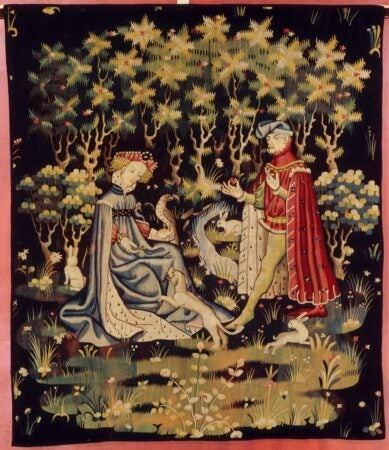
Arras. Offering of the Heart. c. 1400-1410. Image and data from the Réunion des musées nationaux / Art Resource, N.Y.
May the spirit of gratitude stir your soul — studies show it’s even good for your health!
– Nancy Minty, Collections Editor
Collections in JSTOR:
Bob Gore: Faith-based Communities
Museum of Fine Arts, Houston
Art Institute of Chicago
Cleveland Museum of Art
Jorge Durand and Douglas Massey: Mexican Retablos
Magnum Photos
Erich Lessing Culture and Fine Arts Archives
Metropolitan Museum of Art
Fine Arts Museums of San Francisco
American Folk Art Museum
Réunion des musées nationaux
From JSTOR Daily:
Stories about the history of Thanksgiving
